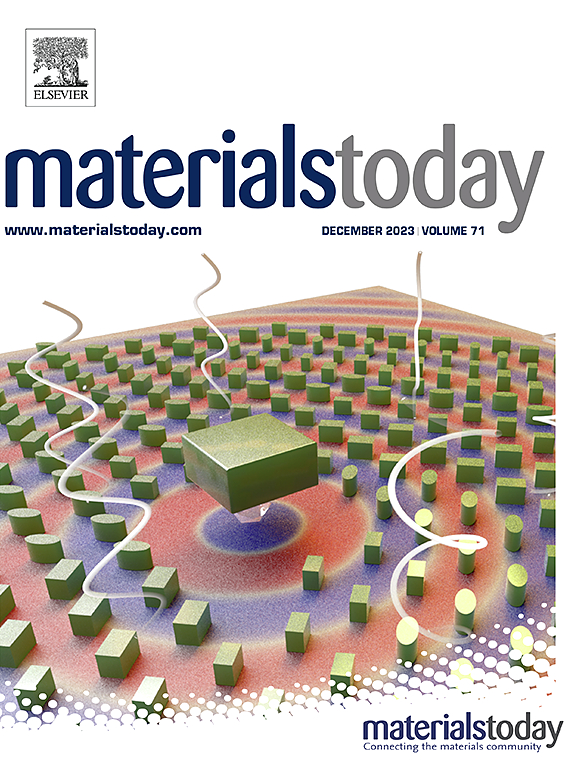具有可编程多形状存储器的温度响应多稳定kirigami
IF 21.1
1区 材料科学
Q1 MATERIALS SCIENCE, MULTIDISCIPLINARY
引用次数: 0
摘要
形状记忆材料在没有外部约束的情况下保持临时形状,并在暴露于外部触发(例如光、湿度或热)时恢复到其永久形状。目前的形状记忆材料可以保持一定数量的形状,提供有限的变形模式和不期望的回弹,承受缓慢的响应速度,并且通常需要费力的热机械编程和通过改变化学成分来调整其玻璃化转变温度。在这项工作中,我们展示了在一类3d打印基里格米中实现鲁棒和简化的多形状记忆效应,该基里格米仅依赖于两种具有不同温度依赖弹性模量的现成聚合物。通过在低温条件下对基里伽米多稳定性进行编程,我们的多形状记忆超材料可以在平面和空间基里伽米镶嵌中重新配置,在通过热诱导刚度反转恢复到其永久形状之前,保留几何上丰富多样的稳定临时形状。通过力学理论、数值模拟和热机械实验,我们首先研究了标志着稳定性转变和变形模式的物理机制,然后利用这些见解来展示它们在各种应用中的多功能性,包括温度传感器、执行器和机器人抓取器。不依赖于材料成分的化学调节,它们的特点包括多种变形模式的传递和组合,丰富而强大的无回弹的多形状记忆效应,可重新编程的形状变化,刚度切换和热诱导的快速形状恢复。我们的策略是通用的,可以适应其他3D打印材料和物理化学刺激,例如光,水分和溶质,并且可以向上和向下缩放,为广泛的多功能应用铺平了道路,包括自适应变形设备,自供电传感器和执行器,以及可重构的软机器人。本文章由计算机程序翻译,如有差异,请以英文原文为准。
Temperature-responsive multistable kirigami with reprogrammable multi-shape memory
Shape memory materials retain temporary shapes without external constraints and return to their permanent shape when exposed to an external trigger, e.g., light, humidity, or heat. Current shape memory materials can maintain a modest number of shapes, deliver limited modes of deformation with undesired spring-back, suffer slow response speed, and typically require laborious thermomechanical programming and tuning their glass transition temperatures through alteration in chemical composition. In this work, we demonstrate the attainment of a robust and simplified multi-shape memory effect in a class of 3D-printed kirigami that merely relies on two off-the-shelf polymers with distinct temperature-dependent elastic moduli. By programming the kirigami multistability in the low-temperature regime, our multi-shape memory metamaterials can be reconfigured in-situ to retain a geometrical rich and diverse set of stable temporary shapes in planar and spatial kirigami tessellations before reverting to their permanent shape through a heat-induced stiffness reversal. Through mechanics theory, numerical simulations, and thermomechanical experiments, we first investigate the physical mechanism that marks stability transitions and deformation modes, and then leverage the insights to demonstrate their multifunctionality in a diverse range of applications, including temperature sensors, actuators, and robotic grippers. Unreliant on the chemistry tuning of material composition, their hallmarks include the delivery of multiple deformation modes and combination thereof, rich and robust multi-shape memory effect with no spring-back, reprogrammable shape changes, stiffness switch, and heat-induced swift shape recovery. Our strategy is versatile, can be adapted to other 3D printable materials and physicochemical stimuli, e.g., light, moisture, and solute, and can be up- and down-scaled, paving the way for a wide range of multifunctional applications, including adaptive morphing devices, self-powered sensors and actuators, and reconfigurable soft robots.
求助全文
通过发布文献求助,成功后即可免费获取论文全文。
去求助
来源期刊

Materials Today
工程技术-材料科学:综合
CiteScore
36.30
自引率
1.20%
发文量
237
审稿时长
23 days
期刊介绍:
Materials Today is the leading journal in the Materials Today family, focusing on the latest and most impactful work in the materials science community. With a reputation for excellence in news and reviews, the journal has now expanded its coverage to include original research and aims to be at the forefront of the field.
We welcome comprehensive articles, short communications, and review articles from established leaders in the rapidly evolving fields of materials science and related disciplines. We strive to provide authors with rigorous peer review, fast publication, and maximum exposure for their work. While we only accept the most significant manuscripts, our speedy evaluation process ensures that there are no unnecessary publication delays.
 求助内容:
求助内容: 应助结果提醒方式:
应助结果提醒方式:


